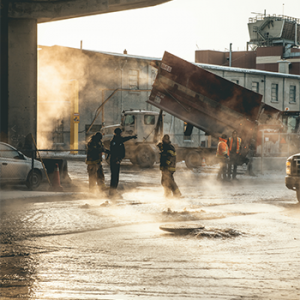The Importance of Controlling Humidity on a Worksite
Humidity can cause a number of problems on construction sites. When the humidity in an area is too high, water vapor in the air can damage building materials, leading to expensive repairs and delays. In addition, excess moisture breeds mold and dust mites, causing respiratory problems for construction workers and residents after the project is complete.
To complete projects on time and ensure they’re mold-free, it’s essential for construction professionals to control humidity levels at all worksites. Solutions for controlling humidity will vary depending on the weather and humidity levels at each location. However, two common solutions are to use heat or a dehumidifier to reduce moisture content at construction sites.
Weather and Humidity
When air is full of water vapor, it tends to feel warmer than it actually is. This affects people because it becomes difficult to sweat when humidity levels are high. Because people sweat to reduce their internal temperature, high humidity levels can make people feel uncomfortably warm. When humid air hits cold surfaces, it leads to condensation.
When the ambient air is warm, it’s able to hold more water vapor. This is why southern states like Florida are more likely to be humid than northern states like Maine. In states like Arizona that experience dry heat, a 100-degree day may feel cooler than a 90-degree day in Florida. When water vapor in the air reaches the dew point, it condenses – becoming clouds in the sky or drops of water on cold surfaces.
What does this mean for a construction site?
In warm states, construction sites will have to deal with more humidity than those in cooler states. The time of year and weather patterns can also affect this. For example, thunderstorms are often accompanied by high humidity. Rain can increase the humidity at an outdoor and indoor construction site.
The first step for controlling humidity at a construction site is to watch the weather. Once construction professionals understand the range of temperatures and seasonal patterns that affect a construction site, they can plan to keep the humidity of the site within the accepted range.

Finding the Ideal Balance
In most cases, construction professionals will need to reduce humidity levels at a site. This will prevent mold growth, protect workers from respiratory issues and ensure no materials become warped. It also speeds up the construction process since some materials take longer to set in damp conditions.
However, there is such a thing as too little humidity. When the air is dry, some construction materials can be negatively affected, cracking and shrinking. Dry air tends to be cold, but it can be quite warm in some parts of the U.S. The best strategies for maintaining proper humidity levels at a site will vary depending on location and combined climate.
On cold sites, some workers may need heaters to complete construction. Heat can help reduce humidity on exterior construction sites, especially during seasons where snow and dampness may be a problem. Heat causes moisture to evaporate so that construction materials stay dry. However, in areas with high humidity, heat works best paired with a dehumidifier.
According to the EPA, the ideal range for indoor relative humidity is between 30% and 50%. If construction sites are kept within this range, there’s a reduced risk for mold or damage to materials. Ideally, relative humidity should be as low as possible within this range – between 30 and 40 for cooler temperatures and 40 and 50 in warmer temperatures.
Solutions for Humidity
Construction professionals deal with humidity on worksites in two ways: with desiccant dehumidifiers and heating systems. Although some construction workers depend on a residential HVAC unit, this isn’t usually a good idea. Most HVAC units aren’t designed to deal with humidity, and blasting the air conditioning can lead to unfavorable working conditions.
The best process for controlling humidity is to consult local conditions and then form a plan to control and routinely test humidity on a site. This is the only way to ensure humid conditions don’t damage materials and lead to delays and higher costs of construction. Plans to control humidity protect construction companies, their workers and their clients.
Ideal combinations of equipment will depend on the conditions of each specific location. For example, a construction site in Arizona might require a humidifier to add moisture to the air and an air conditioner to keep workers cool. In Louisiana, an air conditioner and dehumidifier can work together to control temperature and humidity.
It’s also important to consider airflow and how it relates to humidity at a construction site. For safety reasons, construction sites and all buildings should have regular air exchange between indoor and outdoor air supplies. However, some construction sites may need filters and ventilating humidifiers to ensure hot outdoor air doesn’t condense inside.
Overview of Professional Humidity Control
Controlling the relative humidity at construction sites is essential for meeting deadlines and protecting the quality of materials. Failure to maintain appropriate humidity levels during construction can also lead to respiratory issues for workers and eventual residents.
The best plan for controlling humidity levels depends on each worksite’s temperature and weather conditions. However, there are easy and effective methods to ensure humidity levels stay within the acceptable range at all work sites. With the proper tools and planning, construction professionals can control humidity levels and protect their investments from the dangers of humidity at all construction sites.
Interested in receiving more great construction news, research and content from NCCER? Click here to join our mailing list!

